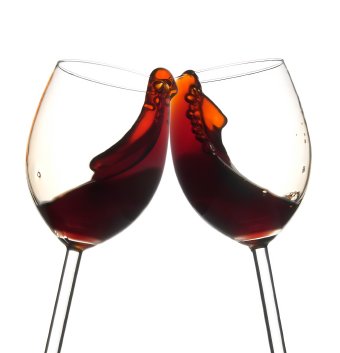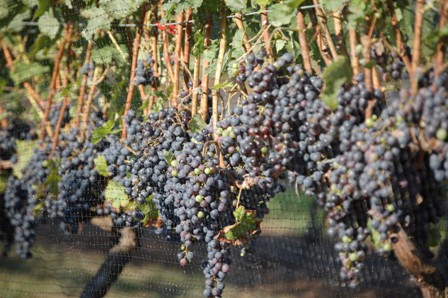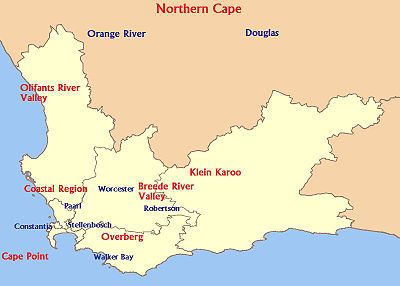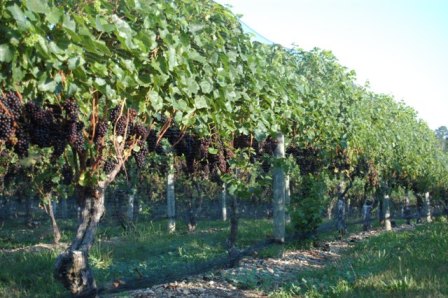|
South African red wine, Pinotage, signature flavor for red wine lovers
African red wine go to: South African red wine has a history dating back to 1659, and at one time Constantia was considered one of the greatest wines in the world. Access to international markets has unleashed a burst of new energy and new investment. Production is concentrated around Cape Town, with major vineyard and production centres at Paarl, Stellenbosch and Worcester. There are about 60 appellations within the Wine of Origin (WO) system, which was implemented in 1973 with a hierarchy of designated production regions, districts and wards. WO wines must be made 100% from grapes from the designated area. "Single vineyard" wines must come from a defined area of less than 5 hectares. An "Estate Wine" can come from adjacent farms, as long as they are farmed together and South African red wine is produced on site. A ward is an area with a distinctive soil type and/or climate, and is roughly equivalent to a European appellation. On 2 February 1659 the founder of Cape Town, Jan van Riebeeck, produced the first South African red wine recorded. In 1685, the Constantia estate was established in a valley facing False Bay by the Governor of the Cape, Simon van der Stel. His Vin de Constance soon acquired a good reputation. But it was Hendrik Cloete, who bought the homestead in 1778, who really made the name of Constantia famous, with an unfortified wine made from a blend of mostly Muscat de Frontignan (Muscat Blanc à Petits Grains), Pontac, red and white Muscadel and a little Chenin Blanc. On 8 January 1918, growers in the Western Cape founded the Koöperatieve Wijnbouwers Vereniging van Zuid-Afrika Bpkt (KWV). KWV came to dominate the industry until the end of apartheid. In the 1930s they set up the South African Wine Farmers Association (SAWFA) as a 50:50 joint venture with their British agents, Vine Products, taking full control after the Second World War. Restrictions on the sale of "whites man's liquor" to black South Africans were lifted in the 1960s. Restrictions were never placed on Coloured South African laborers for fear of collapsing the wine farm labour force. Production quotas were abolished in the 1990s, and KWV relinquished its regulatory functions to the South African Wine Industry Trust and its producing interests to the Wijngaard Co-operative, leaving a publicly quoted marketing company.
History The roots of the South African red wine industry can be traced to the explorations of the Dutch East India Company which established a supply station in what is now modern day Cape Town. A Dutch surgeon, Jan van Riebeeck, was given the task of managing the station and planting vineyards to produce South African red wines and grapes intended to ward off scurvy amongst sailors during their voyages along the spice route. The first harvest and crushing took place in 1659, seven years after landing in 1652. The man succeeding Van Riebeeck as governor of the Cape of Good Hope, Simon van der Stel, sought to improve the quality of viticulture in the region. In 1685, Van der Stel purchased a large 1,850 acres estate just outside Cape Town, establishing the Constantia wine estate. After Van der Stel's death, the estate fell into disrepair but was revived in 1778 when it was purchased by Hendrik Cloete. Under Cloete, Constantia soon earned a reputation across Europe for the quality of its Muscat based dessert wines. The reputation of Constantia positively affected perception of other Cape wines and when the area fell under British rule, large quantities of Cape wine were exported to Great Britain. By 1859 more than 1 million gallons (45,000 hl) of South African wine were exported to Britain. The region experienced a period of prosperity that lasted until the 1860s when the Cobden-Chevalier Treaty signed by the Gladstone government and France reduced the preferential tariffs that benefited South African red wine to the detriment of French wine exports. By 1865, exports dried up to less than 150,600 gallons. In 1866 the phylloxera epidemic reached South Africa, causing widespread devastation to the industry and vineyards that would take more than 20 years to recover. While many growers gave up on winemaking, choosing instead to plant orchards and alfalfa fields to feed the growing ostrich feather industry. The growers that did replant with grapevines, chose high yielding grape varieties such as Cinsaut. By the early 1900s more than 80 million vines had been replanted, creating a wine lake. Some producers would pour unsaleable South African red wine into local rivers and streams. The depressed price caused by the imbalance between supply and demand prompted the South African government to fund the formation of the Koöperatieve Wijnbouwers Vereniging van Zuid-Afrika Bpkt (KWV) in 1918. Initially started as a co-operative, the KWV soon grew in power and prominence to where it set policies and prices for the entire South African red wine industry. To deal with the wine glut, the KWV restricted yields and set minimum prices that encouraged the production of brandy and fortified wines. For much of the 20th century, the South African red wine industryreceived very little attention on the world stage. Its isolation was exacerbated by the boycotts of South African products in protest against the country's system of Apartheid. It was not till the late 1980s and 1990s when Apartheid was ended and the world's export market opened up that South African red wines began to experience a renaissance. Many producers in South Africa quickly adopted new viticultural and winemaking technologies. The presence of flying winemakers from abroad brought international influences and focus on well known varieties such as Shiraz, Cabernet Sauvignon and Chardonnay. The reorganization of the powerful KWV co-operative into a private business further sparked innovation and improvement in quality as vineyard owners and wineries who had previously relied on the price-fixing structure that bought their excess grapes for distillation were forced to become more competitive by shifting their focus to the production of quality South African red wine. In 1990, less than 30% of all the grapes harvested was used for wine production meant for the consumer market with the remaining 70% being discarded, distilled into brandy or sold as table grapes and juice. By 2003 the numbers had been reversed with more than 70% of the grapes harvested that year reaching the consumer market as wine.
Climate South Africa is located at the tip of the African continent with most South African red wine regions located near the coastal influences of the Atlantic and Indian Oceans. These regions have mostly a Mediterranean climate that is marked by intense sunlight and dry heat. Winters tend to be cold and wet with potential snowfall at higher elevations. The threat of springtime frost is rare with most South African red wine regions seeing a warm growing season between November and April. The majority of annual precipitation occurs in the winter months and ranges from 9.7 inches (246.38 mm) in the semi-desert like region of Klein Karoo to 59 inches (1,498.60 mm) near the Worcester Mountains. Regions closer to the coast or in the rain shadow of inland mountain chains like the Drakenstein, Hottentots Holland and Langeberg will have more rain than areas further in land. In many South African red wine regions irrigation is essential to viticulture. The Benguela current from Antarctica brings cool air off the south Atlantic coast that allows the mean temperatures of the area to be lower than regions of comparable latitude. A strong wind current, known as the Cape Doctor, brings gale force winds to the South African red wine regions along the Cape which has the positive benefit of limiting the risk of various mildew and fungal grape disease as well as tempering humidity but can also damage grape vines that are not protected. During the harvest months of February and March, the average daily temperatures in many South African red wine regions is 73 °F (23 °C) with spikes up to 104 °F (40 °C) not uncommon in the warm inland river valleys around the Breede, Olifants and Orange Rivers. On the Winkler scale the majority of South African red wine regions would be classified as Region III locations with heat summation and degree days similar to the California wine region of Oakville in Napa Valley. Warmer regions such as Klein Karoo and Douglas fall into Region IV (similar to Tuscany) and Region V (similar to Perth in Western Australia) respectively. New plantings are focus on cooler climate sites in Elgin and Walker Bay regions as characterized as Region II with temperatures closer to the Burgundy and Piedmont. The South African red wine regions are spread out over the Western and Northern Cape regions, covering 312 miles (502 km) west to east and 420 miles (680 km) north-south. Within this wide expanse is a vast range of macroclimate and vineyard soil types influenced by the unique geography of the area which includes several inland mountain chains and valleys. Within the Stellenbosch region alone, there are more than 50 unique soil types. In general, the soils of South Africa tend to retain moisture and drain well, having a significant proportion of clay (often at least 25% of the composition) with low pH levels around 4. The pH levels of the soils are often adjusted with lime and calcium treatment. Other soil types found in South Africa includes granite and sandstone in Constantia, shale in Elgin and arenaceous shale in Walker Bay. Near the river valleys, the soils are particularly lime rich with high proportion of sand and shale.
Regions As of 2003, South Africa was 17th in terms of acreage planted with the country owning 1.5% of the world's grape vineyards with 270,600 acres (109,500 ha). Yearly production among South Africa's wine regions is usually around 264 million gallons (10 million hl) which regularly puts the country among the top ten wine producing countries in the world. The majority of South African red wine production takes place in the Cape, particularly the southwest corner near the coastal region. The historical heart of South African red wine has been the area near the Cape Peninsula and modern day Cape Town. This area is still of prominence in the industry being home to the major South African red wine regions of Constantia, Stellenbosch and Paarl. Today South African red wine is grown throughout the Western Cape and in parts of the Northern Cape, KwaZulu-Natal and Eastern Cape regions. The river regions along the Breede Valley, Olifants and Orange Rivers are among the warmest areas and are often the location of bulk wine production and distillation. The cooler climate regions east of Cape Town along the Indian coast, such as Walker Bay and Elgin, have seen vast expansion and development in recent years as producers experiment with cool climate varietals and wine styles. Under the Wine of Origins legislation, wine regions in South Africa are divided into 4 classifications-geographical unit, region, district and wards. Below are some notable WOs. Constantia The boundaries of this ward include the historic Constantia estate, though the ward and the three wine estates later built upon the 1,853 acres (750 ha) estate are separate entities. The Constantia ward is located south of Cape Town on the Cape Peninsula that juts out into the Atlantic ocean. Because of this location, the wine region receives oceanic influences on each side that creates a cooling effect that contributes to a long, slow ripening period in the summer where average daily temperatures fall between 64.4–66.2 °F (18–19 °C). Winters are often moderate and mild but wet with annual precipitation usually over 39 inches (990.60 mm). The soil of the region is composed primarily of Table Mountain sandstone with high concentrations of loam and granite. The area grows a wide range of grapes with Sauvignon blanc being particularly noted. Stellenbosch The Stellenbosch district is the second oldest wine region in South Africa, after Constantia, and is responsible for around 14% of the country's annual wine production. First planted in 1679, Stellenbosch is located 28 miles (45 km) east of Cape Town. The region is surrounded by the Helderberg, Simonsberg and Stellenbosch Mountains and receives some climatic influences from nearby False Bay. The bay tempers the climate and keep average temperatures during the summer growing season to around 68 °F (20 °C), just slightly warmer than Bordeaux. Vineyard soil types range from decomposed granite on the hillside near the mountains to sandy alluvial loam in the valleys near the rivers. The seven wards of Stellenbosch-Banghoek, Bottelary, Devon Valley, Jonkershoek Valley, Papegaaiberg, Polkadraai Hills and Simonsberg-Stellenbosch are well known for their red wine production that demonstrate terroir distinction-particularly Cabernet Sauvignon, Merlot, Pinotage and Shiraz. Simonsberg was the first wine ward to gain individual distinction. White wine production centers around Chardonnay and Sauvignon blanc which are often blended together. The western reaches of Stellenbosch, such as Bottelary and near Elsenburg also include a sizable portion of Chenin blanc plantings in areas rich in light, sandy soils. Paarl For most of the 20th century, Paarl was for all practical purposes the heart of the South African red wine industry. It was the home of the KWV as well as the annual Nederburg Wine Auction where the reputation of a vintage or an estate could be established. Gradually the focus shifted southwards to Stellenbosch where Stellenbosch University gained a more prominent role in the South African red wine industry with its viticulture and winemaking programs. The transfer of power from the KWV to a private business further shifted the focus away from Paarl. However, the terroir driven wines of its wards, the Franschhoek Valley and Wellington, have revitalized interest in the area in recent years. The fortified wine produced in Paarl and nearby Tulbagh can be designated with the unique WO of Boberg relating to its proximatelyto the Berg river. Franschhoek Valley The Franschhoek Valley was founded by Huguenot settlers who brought with them from their native France their traditions and winemaking expertise. The ward includes some higher elevation vineyard sites which can produced full flavoured white wines with noticeable acidity levels. Breede River Valley The Breede River Valley, located east of the Drakenstein Mountains, is a warm climate region that can be very dry and arid in some places. The river itself provides easy access to irrigation which makes bulk wine production of high yield varieties commonplace. The Robertson district is located closest to the river along alluvial soils and the occasional calcium-rich outcrop of land. The average annual precipitation hovers around 16 inches (406.40 mm) with temperatures during the summer growing seasonal normally staying around 72 °F (22 °C). The Bonnievale ward is the most notable sub-region of Robertson, noted for its Chardonnay and Shiraz wines. The Worcester district is responsible for more wine than any other wine region in the country with one fifth to one quarter of the entire South African yearly wine production coming from this area.Located just beyond Du Toit's Peak in the Breede River Valley, Worcester includes a broad fertile plain that relies on irrigation due to its dry, arid climate. The area's large and numerous co-operatives produce sizable amounts of fortified wine as well as Muscadel and Hanepoot based dessert wines. In recent years the Slanghoek ward shared with Breedekloof district has seen success growing botrytized and dry Sauvignon blanc wines. The Worcester district is home to nearly half of all the Semillon and a third of Ruby Cabernet planted in South Africa with sizable plantings of Colombard and Chenin blanc. Overberg The cool climate Overberg region has been the site of the most recent interest and development in the South African wine industry, particularly with increased plantings of Chardonnay and Pinot noir. The entire area received very little attention until the late 20th century and was not even classified in 1973 within the original "Wine of Origins" program.[7] The maritime climate of Walker Bay and the cool, higher elevation vineyards of Elgin located east of Cape Town have had success producing these varietals as well as Sauvignon blanc.
Other Notable Regions The Klein Karoo region (meaning Little Karoo) has a semi-desert climate and was known mostly for sheep and ostrich farming. The region stretches from Montagu in the west to the village of De Rust in the east. In Calitzdorp ward temperatures are moderated by sea breezes that start in the late afternoon and cool night time temperatures. Wine production in the area is largely centered around fortified "port-style" wine and Muscadels. The Atlantic influenced "West Coast" region includes the wine making areas of Durbanville, Olifants River, Piketberg and Swartland. While historically this region was known for its large, bulk wine production in recent years producers have focused on premium wine production such as plantings of Sauvignon blanc in the Groenekloof area near Darling and Pinotage in unirrigated farmland of Swartland. In the Olifants River region, Chenin blanc and Colombard are popular. The area is also home to South Africa's biggest single co-operative winery - the Vredendal Co-operative. The Northern Cape wine regions located along the Orange river include the hottest wine producing areas in South Africa. Wine production here was slow to take root, delayed to the 1960s when better irrigation and temperature control fermentation technology became available. Today the area is responsible for nearly 12% of all the wine produced in South Africa-mostly by large co-operatives for bulk wine production. The Hartswater region, located 50 miles (80 km) north of Kimberley is South Africa's northernmost wine region. KwaZulu-Natal was designated as a Geographical Unit in 2005 and is one of South Africa's most recent wine regions. The first wine estate in this region is The Stables Wine Estate and the region's first Wine of Origin wine was released by Tiny and Judy van Niekerk in July 2006. Current cultivars doing really well in the growing wine region of KwaZulu-Natal are Sauvignon Blanc, Pinotage, Pinot Noir and Chardonnay. With mild summer temperatures the region boasts South Africa's coolest vineyards. Other Notable Wards The Ruiterbosch ward, located southwest of Klein Karoo around Mossel Bay, has a generally cool climate influenced primarily by the Indian Ocean. The area is planted primarily with Riesling, Sauvignon blanc and Pinot noir.[5] The Cederberg located east of the southern reaches of the Olifants rivers includes some of the highest elevated vineyards in South Africa, planted at altitudes more than 3,300 feet (1,000 m).
Wine The winemaking traditions of South Africa often represent a hybridization of Old World wine making and the new. Since the end of Apartheid, many producers have been working on producing more "international" styles of wine that can be successful on the world market. Flying winemakers from France, Spain and California have brought new techniques and styles to South Africa. In the 1980s, the use of oak barrels for fermentation and aging became popular. The use of chaptalization is illegal in South Africa as the country's warm climate makes attaining sufficient sugar and alcohol levels for wine production non-problematic. Winemakers more often have problems with low acidity levels which require supplementation with additional acids like tartaric acid. Today the focus in the South African wine industry has been on increasing the quality of wine production-particularly with the more exportable and fashionable red grape varieties. Traditionally South African red wines had a reputation for being coarse in texture with rustic flavors. The Afrikaans word dikvoet used to describe these wines meant literally "thick foot". In the vineyards, growers focused yield control for better ripeness while winemakers used modern techniques to create softer, fleshier wines. Temperature control fermentation as well as controlled malolactic fermentation were more widely used as well as less dependency on filtration as a means of stabilization.
Pinotage Pinotage is the South African red wine grape signature variety. It was bred there in 1925 as a cross between Pinot noir and Cinsaut (Cinsaut was known as Hermitage in South Africa during that time, hence the portmanteau name of Pinotage). It typically produces deep red varietal wines with smoky, bramble and earthy flavors, sometimes with notes of bananas and tropical fruit, but has been criticized for sometimes smelling of acetone. Pinotage is often blended, and also made into fortified South African red wine and even red sparkling wine. The grape is a viticultural cross of two varieties of Vitis vinifera, not a hybrid.

Pinotage is a grape variety that was created in South Africa in 1925 by Abraham Izak Perold, the first Professor of Viticulture at Stellenbosch University. Perold was attempting to combine the best qualities of the robust Hermitage with Pinot Noir, a grape that makes great South African red wine but can be difficult to grow. Perold planted the four seeds from his cross in the garden of his official residence at Welgevallen Experimental Farm and then seems to have forgotten about them. In 1927 he left the university for a job with KWV co-operative and the garden became overgrown. The university sent in a team to tidy it up, just as Charlie Niehaus happened to pass by. He was a young lecturer who knew about the seedlings, and rescued them from the clean-up team. The young plants were moved to Elsenburg Agricultural College under Perold's successor, CJ Theron. In 1935 Theron grafted them onto newly established Richter 99 and Richter 57 rootstock at Welgevallen. Meanwhile Perold continued to visit his former colleagues. Theron showed him the newly grafted vines, and the one that was doing best was selected for propagation and was christened Pinotage. The first wine was made in 1941 at Elsenburg, with the first commercial plantings at Myrtle Grove near Sir Lowry's Pass. Also in 1941 Pinotage vines were planted at the Kanonkop Estate, the wines of which have later risen to great fame and can mature up to 25 years, so that this estate has even been called “a formidable leader of Cape’s red wine pack.” The first recognition came when a Bellevue wine made from Pinotage became the champion South African red wine at the Cape Wine Show of 1959. This South African red wine would become the first wine to mention Pinotage on its label in 1961, when Stellenbosch Farmer's Winery (SFW) marketed it under their Lanzerac brand. This early success, and its easy viticulture, prompted a wave of planting during the 1960s.The majority of the world's plantings of Pinotage is found in South Africa, where it makes up just 6.7% of the vineyard area but is considered a symbol of the country's distinctive winemaking traditions. It is a required component (30-70%) in "Cape blends". Here it is made into the full range of styles, from easy-drinking quaffing wine and rosé to barrel-aged wine intended for cellaring. It is also made into a fortified 'port' style, and even a red sparkling wine. The grape is very dependent on the skill and style of winemaking, with well made examples having the potential to produce deep colored, fruity wines that can be accessible early as well as age.
African red wine go to: Thank you Wikipedia for the content on this page. Return from South African Red Wine to Types of Red Wine
|
Sign up for weekly Red Wine Reviews
CLICK HEREWe will send you the extremely popular Red-Wine-Home tasting terms when you sign-up.








